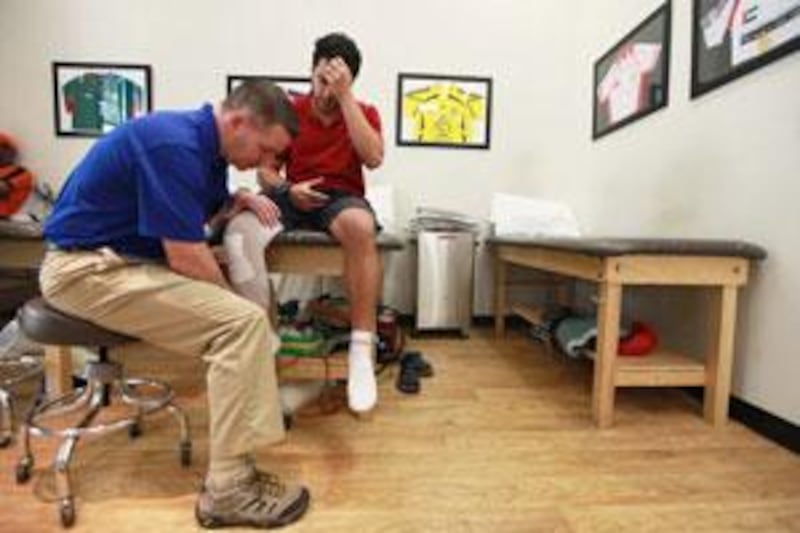ABU DHABI // Specialists have started calling it "Arab knee". Partly because of a slightly different bone structure, Arabs appear to be injuring their knees earlier and more often than people in other parts of the world. According to Dr Charles Brown, the director of the Abu Dhabi Knee and Sports Medicine Centre and one of the specialists who has documented the phenomenon, the downwards slope of the tibia - the second largest bone in the body after the femur or thigh bone - is more slanted among Arabs than westerners.
Dr Brown, who is also a consultant orthopaedic surgeon, said studies by the centre showed a recreational football player in the UAE was five times more likely to suffer a serious knee injury requiring surgery than one in Europe or the US. Furthermore, people in the UAE who tear their anterior cruciate ligament (ACL) do so more often than not while playing football. The centre's data show that the incidence of ACL injuries in the Emirates is one in every 600 people, compared to one in every 3,000 in the US.
Two other kinds of knee injuries are also widespread in the UAE: tears in the menisci, the knee's cartilages, and osteoarthritis, which affects the articular cartilage of the knee joint and is usually prompted by ageing. In the UAE, however, Dr Brown has seen cases of osteoarthritis among patients in the late 30s and early 40s, decades earlier than when they appear in his patients in the US. Dr Mike van Steijn, senior consultant orthopaedic surgeon at the Dubai Bone and Joint Centre, also subscribes to the "Arab knee" theory.
"We have no clear numbers, but there is certainly a greater number of ACL tears among Arabs than among patients in the US and Europe," said Dr van Steijn. "There is a definite anatomical difference between the two types of knees, specifically in the slope on the top part of the tibia." Dr van Steijn said a lack of education on how to exercise safely and train properly might also play a role in the increased incidence of knee injuries in the region.
"We see more younger people with osteoarthritis in the UAE, and one of the reasons why you can get osteoarthritis is obesity," said Dr van Steijn. "With obesity, you are told to exercise in order to lose weight, and people who are not fit suddenly start physical activity and do it incorrectly, which results in knee injuries." Dr van Steijn said repeated knee injuries over time, however minor, could lead to osteoarthritis setting in early.
Cultural differences could also contribute to weakened knees, doctors said. Constant kneeling, such as in prayer, causes the knee to become more flexible and places more pressure on the knee joint, which may make it more prone to injury, said Dr Brown. Also, "people of this region tend to sit on the floor and cross-legged more, or sit on lower couches that cause them to bend their knees differently", he said.
Dr Brown, whose centre performed more than 500 ACL reconstruction surgeries last year alone, would like to see more research to fully establish the reasons for the high knee injury rate. "We need people who have knee complaints to get them checked out before a need to replace the joint sets in and you still have a chance to save the knee," he said. "We need awareness programmes out there that show there are potential solutions to knee pain before the knee wears out."
hkhalaf@thenational.ae





